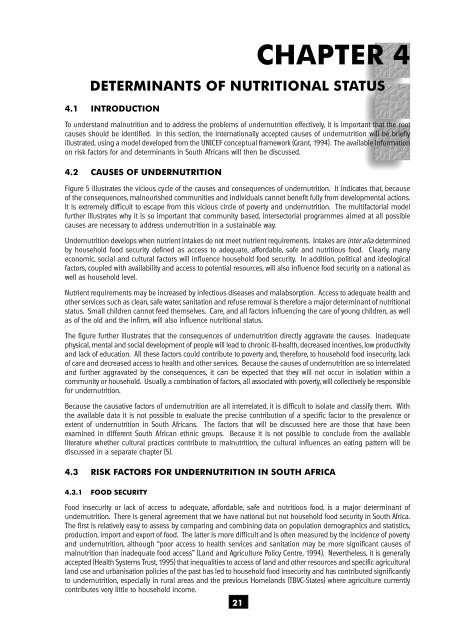the nutritional status of - Health Systems Trust
the nutritional status of - Health Systems Trust
the nutritional status of - Health Systems Trust
You also want an ePaper? Increase the reach of your titles
YUMPU automatically turns print PDFs into web optimized ePapers that Google loves.
CHAPTER 4<br />
DETERMINANTS OF NUTRITIONAL STATUS<br />
4.1 INTRODUCTION<br />
To understand malnutrition and to address <strong>the</strong> problems <strong>of</strong> undernutrition effectively, it is important that <strong>the</strong> root<br />
causes should be identified. In this section, <strong>the</strong> internationally accepted causes <strong>of</strong> undernutrition will be briefly<br />
illustrated, using a model developed from <strong>the</strong> UNICEF conceptual framework (Grant, 1994). The available information<br />
on risk factors for and determinants in South Africans will <strong>the</strong>n be discussed.<br />
4.2 CAUSES OF UNDERNUTRITION<br />
Figure 5 illustrates <strong>the</strong> vicious cycle <strong>of</strong> <strong>the</strong> causes and consequences <strong>of</strong> undernutrition. It indicates that, because<br />
<strong>of</strong> <strong>the</strong> consequences, malnourished communities and individuals cannot benefit fully from developmental actions.<br />
It is extremely difficult to escape from this vicious circle <strong>of</strong> poverty and undernutrition. The multifactorial model<br />
fur<strong>the</strong>r illustrates why it is so important that community based, intersectorial programmes aimed at all possible<br />
causes are necessary to address undernutrition in a sustainable way.<br />
Undernutrition develops when nutrient intakes do not meet nutrient requirements. Intakes are inter alia determined<br />
by household food security defined as access to adequate, affordable, safe and nutritious food. Clearly, many<br />
economic, social and cultural factors will influence household food security. In addition, political and ideological<br />
factors, coupled with availability and access to potential resources, will also influence food security on a national as<br />
well as household level.<br />
Nutrient requirements may be increased by infectious diseases and malabsorption. Access to adequate health and<br />
o<strong>the</strong>r services such as clean, safe water, sanitation and refuse removal is <strong>the</strong>refore a major determinant <strong>of</strong> <strong>nutritional</strong><br />
<strong>status</strong>. Small children cannot feed <strong>the</strong>mselves. Care, and all factors influencing <strong>the</strong> care <strong>of</strong> young children, as well<br />
as <strong>of</strong> <strong>the</strong> old and <strong>the</strong> infirm, will also influence <strong>nutritional</strong> <strong>status</strong>.<br />
The figure fur<strong>the</strong>r illustrates that <strong>the</strong> consequences <strong>of</strong> undernutrition directly aggravate <strong>the</strong> causes. Inadequate<br />
physical, mental and social development <strong>of</strong> people will lead to chronic ill-health, decreased incentives, low productivity<br />
and lack <strong>of</strong> education. All <strong>the</strong>se factors could contribute to poverty and, <strong>the</strong>refore, to household food insecurity, lack<br />
<strong>of</strong> care and decreased access to health and o<strong>the</strong>r services. Because <strong>the</strong> causes <strong>of</strong> undernutrition are so interrelated<br />
and fur<strong>the</strong>r aggravated by <strong>the</strong> consequences, it can be expected that <strong>the</strong>y will not occur in isolation within a<br />
community or household. Usually, a combination <strong>of</strong> factors, all associated with poverty, will collectively be responsible<br />
for undernutrition.<br />
Because <strong>the</strong> causative factors <strong>of</strong> undernutrition are all interrelated, it is difficult to isolate and classify <strong>the</strong>m. With<br />
<strong>the</strong> available data it is not possible to evaluate <strong>the</strong> precise contribution <strong>of</strong> a specific factor to <strong>the</strong> prevalence or<br />
extent <strong>of</strong> undernutrition in South Africans. The factors that will be discussed here are those that have been<br />
examined in different South African ethnic groups. Because it is not possible to conclude from <strong>the</strong> available<br />
literature whe<strong>the</strong>r cultural practices contribute to malnutrition, <strong>the</strong> cultural influences an eating pattern will be<br />
discussed in a separate chapter (5).<br />
4.3 RISK FACTORS FOR UNDERNUTRITION IN SOUTH AFRICA<br />
4.3.1 FOOD SECURITY<br />
Food insecurity or lack <strong>of</strong> access to adequate, affordable, safe and nutritious food, is a major determinant <strong>of</strong><br />
undernutrition. There is general agreement that we have national but not household food security in South Africa.<br />
The first is relatively easy to assess by comparing and combining data on population demographics and statistics,<br />
production, import and export <strong>of</strong> food. The latter is more difficult and is <strong>of</strong>ten measured by <strong>the</strong> incidence <strong>of</strong> poverty<br />
and undernutrition, although “poor access to health services and sanitation may be more significant causes <strong>of</strong><br />
malnutrition than inadequate food access” (Land and Agriculture Policy Centre, 1994). Never<strong>the</strong>less, it is generally<br />
accepted (<strong>Health</strong> <strong>Systems</strong> <strong>Trust</strong>, 1995) that inequalities to access <strong>of</strong> land and o<strong>the</strong>r resources and specific agricultural<br />
land use and urbanisation policies <strong>of</strong> <strong>the</strong> past has led to household food insecurity and has contributed significantly<br />
to undernutrition, especially in rural areas and <strong>the</strong> previous Homelands (TBVC-States) where agriculture currently<br />
contributes very little to household income.<br />
21
















